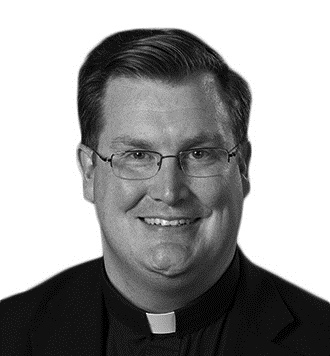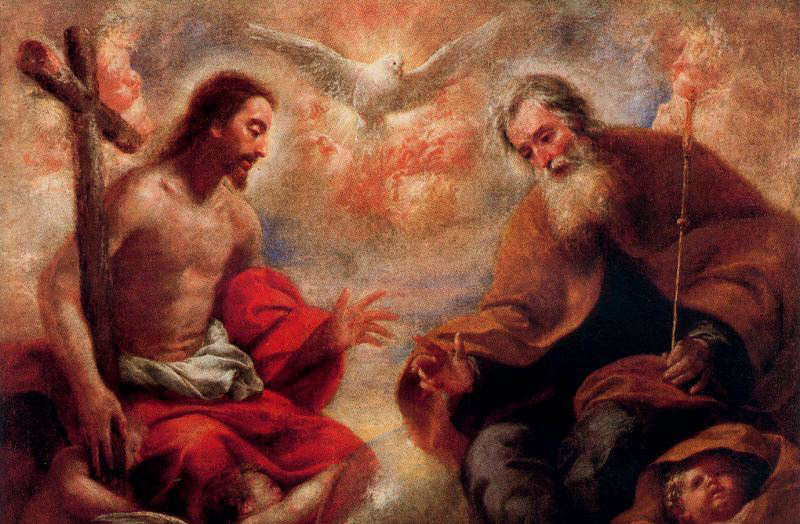Our belief in the Holy Trinity, that there are three distinct yet equal Persons in the one true God, is such a lofty and such an all-encompassing truth that it can be difficult to see clearly the connection to our practical lives. And yet, the fact that God is a Trinity of Father, Son, and Holy Spirit — even though it is a truth above all things — is also a truth at the heart of everything: everything we know, everything we think or do, and everything that happens to us.
But among all of the experiences of the Holy Trinity we have in this life, there is none so powerful as the experience we have at Mass. Every time we celebrate the Eucharist, we encounter God in the most direct, deepest, most intimate, most powerful way possible on earth. The Mass is a foretaste — you might say a “sneak preview” — of the total and perfect union with God we will have in heaven.
In order to understand how we encounter God in the Mass, we need to know something about God’s inner life, meaning, the life shared between the three Persons of the Trinity. To put it briefly, the Father, Son and Holy Spirit are not just sitting up there in heaven. There are between the three Persons of the Trinity dynamic relationships, relationships of love that are the root and foundation of our experience of love here on earth.
This life of God’s love is the life that awaits us in heaven. Jesus tells us in the Gospel of John that one of the reasons for His Ascension is to prepare a place for us in heaven. This is the same passage in which Jesus tells us that in His Father’s house, “there are many dwelling places.” We are called not just to live somewhere in heaven, but to live with God, sharing in His very life.
Again, the Mass is a foretaste of this life, and so we need to see that each time we come to Mass God wants to draw us more and more deeply into His life, in large measure so that He can prepare us for heaven.
We begin and end each Mass by invoking the names of the three Persons of the Trinity — Father, Son and Holy Spirit — as we make the Sign of the Cross and as the priest gives the final blessing. In between these two moments, there are many references to the Trinity we might sometimes miss because we are so familiar with the Mass and don’t always think clearly enough about what we’re doing.
The basic theme — and perhaps the one thing to remember from this article if you don’t remember anything else — is that generally speaking in the Mass we are praying to the Father, through the Son, and in the Holy Spirit. This is not an exceptionless rule, but it is the basic thrust of the Mass.
The basic theme — and perhaps the one thing to remember from this article if you don’t remember anything else — is that generally speaking in the Mass we are praying to the Father, through the Son, and in the Holy Spirit. This is not an exceptionless rule, but it is the basic thrust of the Mass.
In the Mass we are caught up in something infinitely greater than our own private prayer: we participate in the worship that Jesus gives to His Father right now in heaven. We could never do this without the divine power of Jesus Christ and the Holy Spirit making it possible.
We see this basic thrust in action from very early on in the Mass, when we pray the Opening Prayer. After the priest says, “Let us pray,” he says a prayer addressed to the Father, and concludes the prayer by saying, “We ask this through Our Lord Jesus Christ, your Son, who lives and reigns with you in the unity of the Holy Spirit, one God forever and ever.”
It is also clear in the Preface of the Eucharistic Prayer that our worship is directed to the Father, when we begin with a prayer such as, “It is truly right and just, our duty and our salvation, always and everywhere to give you thanks, Lord, holy Father, almighty and eternal God” (Preface of the Most Holy Trinity). Each of the Eucharistic Prayers also begins by addressing the Father as either “Father” or “Lord,” but each also contains both an epiclesis — when the priest extends his hands over the gifts and calls down the Holy Spirit, and the words of institution spoken by Jesus at the Last Supper, ending with, “Do this in memory of me.”
The prayer that most clearly shows the roles of the Father, Son and Holy Spirit in the Mass is the doxology at the end of the Eucharistic Prayer, when the priest holds up the newly consecrated Body and Blood of Christ and says, “Through him, and with him, and in him, O God, almighty Father, in the unity of the Holy Spirit, all glory and honor is yours, forever and ever.” This prayer shows most clearly that in the Mass we pray to the Father, through the Son, and in the Holy Spirit.
There are many other references to the Persons of the Holy Trinity in the Mass, but these are some of the major ones, which most clearly illustrate the major direction, pattern, and rhythm of the greatest act of worship — the greatest act of any kind in which we are privileged to participate.
Whenever we are tempted to take the Mass for granted, or to think that Mass is dull (for whatever reason), we need to remind ourselves that every Mass is at its core a divine act of worship, and that is our privilege to begin experiencing here on earth the power and the glory of the life that awaits us in heaven: life with the Father, Son, and Holy Spirit, the Most Holy Trinity.
Fr. Charles Fox is a priest of the Archdiocese of Detroit currently assigned to the theology faculty of Sacred Heart Major Seminary. He is also a weekend associate pastor at St. Therese of Lisieux Parish in Shelby Township and chaplain and a board member of St. Paul Evangelization Institute, headquartered in Warren.










